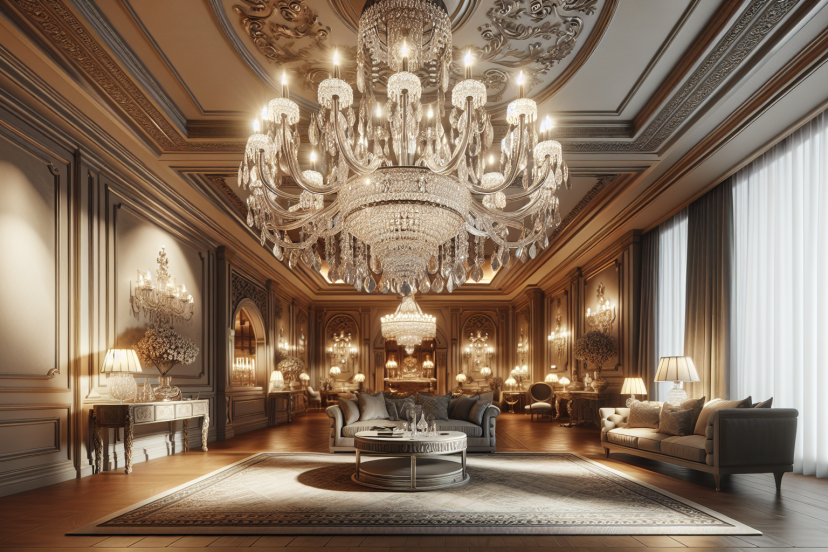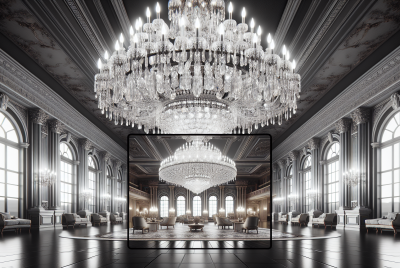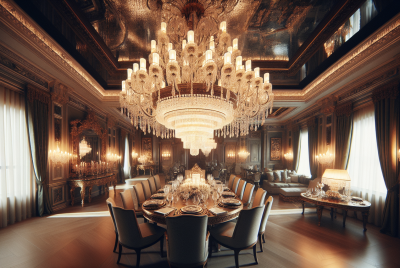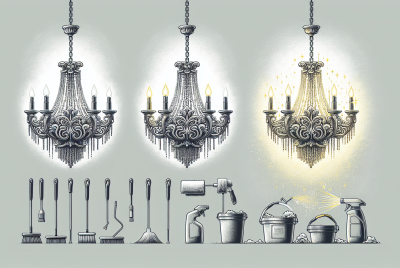Key Factors To Consider When Buying A Chandelier
Are you looking to add an elegant touch to your home? A chandelier may be just what you need! But before you embark on your search for the perfect chandelier, there are a few key factors you should consider. From the size of the room to the style of the fixture, these factors can help ensure that you make the right choice and create a stunning focal point in your space. So, let’s take a closer look at the key factors you should keep in mind when buying a chandelier.

Size and Scale
Determine the right size for your space
When it comes to choosing a chandelier, one of the most important factors to consider is the size and scale of the fixture. You want to make sure that the chandelier you choose is proportionate to the size of your space. A chandelier that is too small will look out of place and insignificant, while a chandelier that is too large can overwhelm the room and make it feel crowded.
To determine the right size for your space, you can follow a simple rule of thumb. Measure the length and width of your room in feet, and then add those two numbers together. The sum of these measurements will give you the ideal diameter, in inches, for your chandelier. For example, if your room is 12 feet long and 10 feet wide, the ideal chandelier diameter would be 22 inches.
Consider the height of the ceiling
Another important factor to consider when choosing a chandelier is the height of your ceiling. The height of your ceiling will determine how low or high your chandelier can hang. If you have low ceilings, you will want to choose a chandelier that is flush or semi-flush mount to ensure it doesn’t hang too low and obstruct the space. On the other hand, if you have high ceilings, you can opt for a chandelier with a longer chain or stem to create a more dramatic effect.
Match the scale of the chandelier to the room
In addition to considering the size and height of your space, it’s also crucial to match the scale of the chandelier to the room. A small chandelier in a large room will look out of place and insignificant, while a large chandelier in a small room can overpower the space. Finding the right balance is key.
Take into account the other furniture and décor in the room when selecting the scale of your chandelier. If you have oversized furniture or a large dining table, a larger chandelier would be more suitable. On the other hand, if you have a small dining area or minimalist furniture, a smaller chandelier would be a better fit.
Style and Design
Choose a chandelier style that complements your decor
When selecting a chandelier, it’s important to choose a style that complements your existing décor. The chandelier should enhance the overall aesthetic of the room rather than clash with it. Consider the style of your furniture, the color scheme, and the overall theme of your space.
For example, if you have a modern, minimalist interior, you might opt for a sleek and simple chandelier with clean lines and minimal embellishments. On the other hand, if your décor is more traditional or ornate, a chandelier with intricate details and decorative elements would be a better choice. By selecting a chandelier that complements your decor, you can create a cohesive and harmonious look in your space.
Consider the overall design of the chandelier
In addition to the style, it’s important to consider the overall design of the chandelier. Chandeliers come in a wide variety of shapes, ranging from traditional and classic to modern and avant-garde. Some chandeliers have multiple tiers or arms, while others have a single, statement-making design.
Consider the placement of the chandelier and how it will interact with the rest of the space. A chandelier with a wide, open design can create a sense of airiness and lightness, while a chandelier with a more enclosed design can create a cozy and intimate atmosphere. The design of the chandelier can have a significant impact on the overall ambiance of the room, so choose wisely.
Match the chandelier to the architectural style of the room
To create a cohesive and harmonious look, it’s important to consider the architectural style of the room when choosing a chandelier. The chandelier should complement the existing architectural features and enhance the overall aesthetic.
For example, if your room has a farmhouse or rustic style, a chandelier made from natural materials like wood and metal would be a great choice. On the other hand, if your space has a contemporary or industrial style, a chandelier with clean lines and a sleek finish would be more suitable.
Matching the chandelier to the architectural style of the room will create a sense of unity and ensure that the chandelier feels like a natural extension of the space.
Lighting Functionality
Evaluate the type and amount of light needed
When choosing a chandelier, it’s important to evaluate the type and amount of light needed in your space. Chandeliers can provide both ambient and task lighting, depending on the design and features.
Consider the function of the room and how the chandelier will be used. For example, in a dining room, you may want a chandelier that provides enough light for dining and entertaining. In a bedroom, you may want a chandelier that creates a soft and relaxing ambiance.
Think about the type of light bulbs that the chandelier uses and whether they provide the desired brightness and color temperature. LED bulbs are a popular choice for chandeliers as they are energy-efficient and long-lasting.
Consider the lighting direction and spread
In addition to the type and amount of light, it’s important to consider the lighting direction and spread of the chandelier. Some chandeliers have adjustable arms or shades that allow you to direct the light where it’s needed most, while others have a more diffused light distribution.
Think about the specific areas in the room that you want to highlight or illuminate. If you have artwork or architectural features that you want to showcase, a chandelier with adjustable lighting would be beneficial. On the other hand, if you want a more general and even distribution of light, a chandelier with diffused lighting would be more suitable.
Choose the right type of bulbs for the chandelier
The type of bulbs you choose for your chandelier can have a significant impact on the lighting functionality. There are a wide variety of bulbs available, each with its own characteristics and benefits.
LED bulbs are a popular choice for chandeliers due to their energy efficiency and long lifespan. They are also available in a range of color temperatures, allowing you to create the desired ambiance in your space. CFL bulbs are another energy-efficient option, but they may take longer to reach their full brightness.
Consider the wattage and lumens of the bulbs to ensure that they provide the desired level of brightness. It’s also important to consider the compatibility of the bulbs with the chandelier and whether they can be easily replaced.
Ceiling Structure
Assess the weight-bearing capacity of the ceiling
Before installing a chandelier, it’s essential to assess the weight-bearing capacity of your ceiling. Chandeliers can vary significantly in weight, depending on their size, materials, and design. It’s crucial to ensure that your ceiling can safely support the weight of the chandelier without any risk of damage or collapse.
Consult a professional if you have any doubts about the structural integrity of your ceiling. They will be able to assess the weight-bearing capacity and determine if any additional support is required.
Consider the height of the ceiling
In addition to assessing the weight-bearing capacity, it’s important to consider the height of your ceiling when choosing a chandelier. The height of the ceiling will determine how low or high the chandelier can hang without causing any obstructions or safety hazards.
If you have low ceilings, it’s advisable to choose a chandelier that is flush or semi-flush mount to ensure it doesn’t hang too low. This will prevent any head injuries or accidents when walking around the room. On the other hand, if you have high ceilings, you can opt for a chandelier with a longer chain or stem to create a more dramatic effect.
Determine if additional support is required
Depending on the weight and size of the chandelier, you may need to install additional support to ensure its stability and safety. This is especially important if you have a heavy or oversized chandelier.
Consult a professional electrician or contractor to assess the installation requirements and determine if any additional support, such as a brace or support beam, is necessary. They will be able to provide expert advice and ensure that the chandelier can be safely installed.
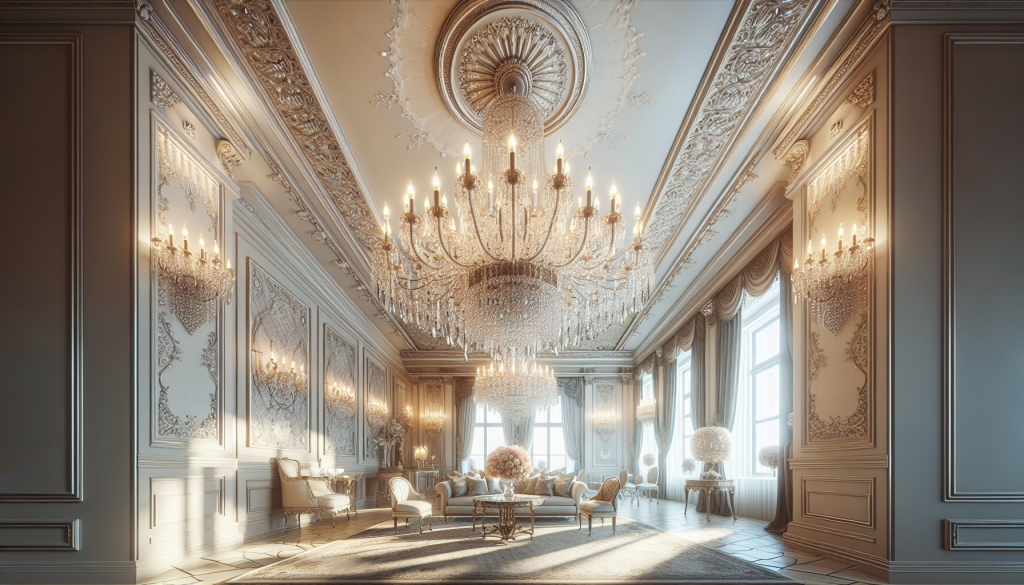
Installation
Decide on the installation method
When it comes to installing a chandelier, there are several methods to choose from. The right installation method will depend on the type of chandelier, the weight, and the structural requirements of your space.
Some common installation methods include flush mount, semi-flush mount, chain hung, and stem hung. Flush mount chandeliers are mounted directly to the ceiling, while semi-flush mount chandeliers have a small gap between the fixture and the ceiling. Chain hung chandeliers use chains to suspend the fixture from the ceiling, while stem hung chandeliers use metal rods or stems.
Consider the style and design of your chandelier when deciding on the installation method. Some chandeliers may only be compatible with certain installation methods, so it’s important to choose one that suits your needs and preferences.
Consider the ease of installation
Another factor to consider when installing a chandelier is the ease of installation. Some chandeliers require professional installation due to their size, weight, or electrical requirements. Others can be installed by homeowners with basic electrical knowledge and DIY skills.
Before attempting to install a chandelier yourself, make sure you understand the electrical wiring and safety precautions involved. If in doubt, it’s always best to consult a professional to ensure a safe and proper installation.
Ensure the chandelier can be safely installed
The safety of the installation should be a top priority when choosing and installing a chandelier. An improperly installed chandelier can pose significant risks, such as electrical hazards or falling fixtures.
Before installing the chandelier, ensure that the electrical wiring is in good condition and compatible with the fixture. If necessary, hire a licensed electrician to handle the electrical connections and ensure compliance with local building codes.
Make sure that the mounting hardware and support system are secure and appropriate for the weight and size of the chandelier. Follow the manufacturer’s instructions and recommendations for installation to ensure a safe and reliable setup.
Maintenance
Determine the maintenance requirements
Like any lighting fixture, chandeliers require regular maintenance to keep them looking their best and functioning properly. Before purchasing a chandelier, it’s important to consider the maintenance requirements and whether they align with your lifestyle and preferences.
Some chandeliers may require more frequent cleaning or dusting due to their design or materials. Others may require periodic bulb replacements or adjustments. Consider the accessibility of the chandelier and whether you have the time and resources to properly maintain it.
Consider the cleaning process
Cleaning a chandelier can be a delicate and time-consuming task, depending on its design and materials. Before purchasing a chandelier, consider the cleaning process and whether it’s something you’re willing to commit to.
Some chandeliers have removable parts or crystal accents that need to be cleaned individually. Others may require professional cleaning to ensure their longevity and shine. Make sure you understand the recommended cleaning methods and whether they are feasible for your lifestyle.
Evaluate the durability of the chandelier
Durability is an important factor to consider when purchasing a chandelier, especially if you want it to be a long-term investment. Chandeliers can be made from a wide range of materials, including metal, glass, crystal, and plastic. Each material has its own level of durability and resistance to wear and tear.
Consider the quality of craftsmanship and the reputation of the manufacturer when evaluating the durability of the chandelier. Read customer reviews and testimonials to get an idea of the chandelier’s longevity and performance over time.
Budget
Set a budget for the chandelier purchase
Before starting your search for the perfect chandelier, it’s essential to set a budget. Chandeliers can vary greatly in price, depending on factors such as size, materials, design, and brand. Having a clear budget in mind will help you narrow down your options and make a more informed decision.
Consider how much you are willing to spend on the chandelier and allocate a portion of your budget for installation and maintenance costs. It’s also important to factor in any additional expenses, such as electrical work or professional cleaning, that may be required.
Consider additional costs such as installation and maintenance
When setting a budget for your chandelier purchase, it’s important to consider not only the cost of the fixture itself but also any additional costs that may arise. Installation and maintenance expenses can add up, especially if you require professional assistance.
If you’re planning to hire a professional electrician or contractor for the installation, make sure to include their fees in your budget. Similarly, if you anticipate the need for regular cleaning or maintenance services, factor those costs into your overall budget.
Evaluate the value for money
While it’s important to set a budget, it’s equally important to evaluate the value for money when purchasing a chandelier. Consider the quality of craftsmanship, the durability of the materials, and the reputation of the manufacturer. A slightly higher investment in a high-quality chandelier may prove to be more cost-effective in the long run, as it will require less maintenance and have a longer lifespan.
Research different brands and compare prices and features to ensure you’re getting the best value for your money. It’s also worth considering any warranty or guarantee offered by the manufacturer, as this can provide added peace of mind.
Energy Efficiency
Choose an energy-efficient chandelier
In today’s environmentally conscious world, energy efficiency is an important consideration when buying any lighting fixture, including chandeliers. Choosing an energy-efficient chandelier can help reduce your carbon footprint and lower your energy bills.
Look for chandeliers that are labeled as energy-efficient or ENERGY STAR certified. These fixtures have been tested and meet strict criteria for energy efficiency. They use less energy than traditional chandeliers without sacrificing brightness or quality of light.
Consider the wattage and lumens of the bulbs
When it comes to energy efficiency, the wattage and lumens of the bulbs used in the chandelier play a significant role. Lower wattage bulbs consume less energy, so opting for bulbs with lower wattage can help reduce your energy consumption.
Lumens, on the other hand, measure the brightness of the bulbs. Consider the desired level of brightness in your space and choose bulbs with an appropriate number of lumens. LED bulbs are a popular choice for their energy efficiency and brightness.
Look for chandeliers with LED or CFL bulbs
When choosing a chandelier, consider the type of bulbs it uses. LED bulbs are highly energy-efficient, long-lasting, and environmentally friendly. They consume less energy than traditional incandescent bulbs and have a much longer lifespan, reducing the need for frequent replacements.
Compact fluorescent lamps (CFL) are another energy-efficient option. They use around 75% less energy than incandescent bulbs and last up to 10 times longer. CFL bulbs are available in a variety of shapes and colors, making them suitable for different chandelier designs.
Opting for chandeliers with LED or CFL bulbs not only reduces your energy consumption but also saves you money on replacement bulbs in the long run.
Dimming Capability
Determine if the chandelier is compatible with dimmer switches
Dimming capability is a desirable feature for many chandelier owners, as it allows you to adjust the brightness and create the desired ambiance in your space. Before purchasing a chandelier, determine if it is compatible with dimmer switches.
Not all chandeliers can be used with dimmer switches, so it’s important to check the specifications and recommendations of the manufacturer. Dimmer switches provide a range of lighting options, from bright task lighting to soft, cozy illumination.
Consider the type of dimming control required
Dimming controls come in various forms, including wall-mounted switches, remote controls, and smart home systems. Consider the type of dimming control that would be most convenient and suitable for your needs.
Wall-mounted switches are a traditional and straightforward option. They allow you to control the brightness of the chandelier directly from a switch on the wall. Remote controls offer convenience and flexibility, allowing you to adjust the lighting from anywhere in the room. Smart home systems enable you to control and automate your chandelier’s dimming functions through a smartphone app or voice commands.
Choose the dimming control option that best aligns with your lifestyle and preferences.
Ensure the chandelier has the desired dimming range
When considering the dimming capability of a chandelier, it’s important to ensure that it has the desired dimming range. Some chandeliers have a limited dimming range, which means they may not be able to achieve the desired level of brightness or dimness.
If you want a chandelier with a wide dimming range, choose one that has been specifically designed for dimming capabilities. Read the manufacturer’s specifications and recommendations to ensure that the chandelier can achieve the desired lighting effects.
Customization Options
Consider options for customizing the chandelier
If you’re looking for a chandelier that reflects your personal style and preferences, consider the customization options available. Some manufacturers offer the ability to customize certain aspects of the chandelier, such as the finish, shade color, or crystal accents.
Customization allows you to create a truly unique and personalized chandelier that complements your decor and reflects your individuality. Whether you want a chandelier with a specific metal finish, a particular shade color, or a particular crystal arrangement, customization options can help bring your vision to life.
Evaluate the availability of matching accessories
When choosing a chandelier, it’s important to consider the availability of matching accessories, such as ceiling medallions or additional lighting fixtures. Matching accessories can help create a cohesive and coordinated look in your space.
Some manufacturers offer a range of matching accessories that are specifically designed to complement their chandelier collections. These accessories can include ceiling medallions, wall sconces, or table lamps. By choosing matching accessories, you can extend the design and style of your chandelier throughout the room.
Look for chandeliers with interchangeable parts
If you like to change up your decor from time to time, look for chandeliers with interchangeable parts. Some chandeliers allow you to easily swap out certain elements, such as crystal pendants or decorative ornaments, to create a different look.
Interchangeable parts offer flexibility and versatility, allowing you to update and refresh your chandelier without replacing the entire fixture. This can be a cost-effective and convenient option for those who like to change their decor frequently or seasonally.
In conclusion, buying a chandelier involves careful consideration of various factors. From the size and scale of the chandelier to the style and design, from the lighting functionality to the ceiling structure, all these elements play a crucial role in selecting the perfect chandelier for your space. Additionally, factors such as installation, maintenance, budget, energy efficiency, dimming capability, and customization options should also be taken into account to ensure a well-informed purchase. By carefully evaluating and addressing each of these factors, you can find a chandelier that not only adds beauty and elegance to your space but also meets your practical needs and personal preferences. So go ahead, explore the wide range of chandeliers available, and find the perfect one to illuminate and enhance your home.

